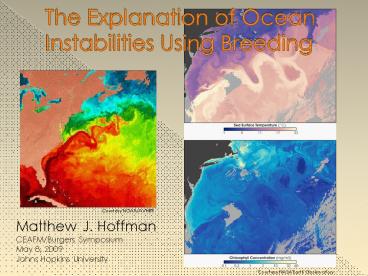Martian Data Assimilation Using the LETKF - PowerPoint PPT Presentation
1 / 25
Title: Martian Data Assimilation Using the LETKF
1
The Explanation of Ocean Instabilities Using
Breeding
Courtesy NOAA/AVHRR
Matthew J. Hoffman CEAFM/Burgers Symposium May 8,
2009 Johns Hopkins University
Courtesy NASA Earth Observatory
2
Outline
- Overview of ocean instabilities
- Overview of the breeding method
- Application to global ocean model
- Development of bred vector energy equations to
diagnose instability dynamics - Study of Pacific tropical instabilities
3
Ocean Instabilities
Ducet et al., 2000
- Flow Instabilities are prevalent in the upper
ocean - Most occur in strong currentswestern boundary
currents, Southern Ocean - Instabilities take place on different timescales
- Tropical Pacific instabilities are some of the
strongest
4
Pacific Tropical Instabilities
Jesse Allen, NASA Earth Observatory SST from
Advanced Microwave Scattering Radiometer on Aqua
- Pacific Tropical Instability Waves are seen in
the Pacific equatorial cold tongue - Periods of 20-30 days, Wavelength of 1000km
- Tropical waves are coupled to the atmospheric
boundary layer and are important for heat and
momentum balances - Masina et al. (1999) argued for baroclinic energy
conversion dominating - Qiao and Weisberg (1995)argued for barotropic
energy conversion dominating
5
Overview of Breeding Method
- Developed by Toth and Kalnay (1993, 1997) to
estimate the shape of growing errors in a
non-linear atmospheric model - Also provides initial conditions for ensemble
forecasting - 2 parameters in the methodrescaling size and
time between rescaling - Parameters can be tuned to isolate instabilities
of different time scales - Yang et al. (2005) used breeding on a coupled GCM
to identify slow growing ENSO modes
6
Overview of Breeding Method
- A small, random perturbation is added to the
initial state of the system - Both the perturbed and unperturbed (control)
conditions are integrated forward in time - The control forecast is subtracted from the
perturbed forecast, yielding the bred vector - The bred vector is rescaled to its initial size
and added to the control forecast as a new
perturbation
7
MOM2 Global Model
- GFDL Modular Ocean Model (MOM) 2b code
- Driven by monthly averaged NCEP reanalysis winds
from 1950-1995 - SST and surface salinity from World Ocean Atlas
1994 - Same setup used by Carton et al. (2000) for SODA
- 1 resolution in longitude, stretched latitude
grid ranging from 1 in midlatitudes to ½ in
tropics - 20 vertical levels 15 meters level thickness
near surface
8
Bred Vectors
- 10 day bred vectors identify many instabilities
in the ocean - Instabilities are seen in the Southern Ocean, in
boundary currents, and in the Tropical Pacific,
among other locations
9
Tropical Pacific Bred Vectors
10
Tropical Pacific Bred Vectors
- Seasonal cycle is clear
- Speed is 0.46m/s
- Wavelength is 1000km
- 25 day period
11
Tropical Pacific Bred Vectors
- Seasonal cycle is clear
- Speed is 0.46m/s
- Wavelength is 1000m
- 25 day period
- Interannual cycle tied to El Niño-La Niña cycle
(ENSO)
El Niño
12
Tropical Pacific Bred Vectors
- Seasonal cycle is clear
- Speed is 0.46m/s
- Wavelength is 1000m
- 25 day period
- Interannual cycle tied to El Niño-La Niña cycle
(ENSO)
La Niña
13
Bred Vector Kinetic Energy
- Momentum Equations
- Kinetic energy defined as
- Bred kinetic energy is
14
Bred Vector Kinetic Energy
- Terms have physical interpretation
15
Bred Vector Kinetic Energy
- Terms have physical interpretation
- Horizontal and vertical divergence of energy
transport
16
Bred Vector Kinetic Energy
- Terms have physical interpretation
- Horizontal and vertical divergence of energy
transport - Work of pressure force
17
Bred Vector Kinetic Energy
- Terms have physical interpretation
- Horizontal and vertical divergence of energy
transport - Work of pressure force
- Baroclinic conversion term
18
Bred Vector Kinetic Energy
- Terms have physical interpretation
- Horizontal and vertical divergence of energy
transport - Work of pressure force
- Baroclinic conversion term
- Barotropic conversion term
19
Bred Vector Kinetic Energy
- Tropical Pacific shows positive conversion (bred
potential to bred kinetic) - Shows Instability Growth
- South Atlantic shows negative conversion (bred
kinetic to bred potential) - Stabilizing region
20
Bred Vector Kinetic Energy
- Tropical Pacific shows positive conversion (bred
potential to bred kinetic) - Shows Instability Growth
- South Atlantic shows negative conversion (bred
kinetic to bred potential) - Stabilizing region
21
Bred Vector Kinetic Energy
- Tropical Pacific shows positive conversion (bred
potential to bred kinetic) - Shows Instability Growth
- South Atlantic shows negative conversion (bred
kinetic to bred potential) - Stabilizing region
22
Tropical Pacific Instabilities
- Monthly averages over a 30 year period are shown
for January - Depth averaged over upper 150m
- Baroclinic conversion is strongest from 3N-5N
- Barotropic conversion is strongest at the equator
- Baroclinic conversion is stronger in this model
- Energy conversion is strongest when bred vectors
are strongest (La Niña)
23
Tropical Pacific Instabilities
At 3.5N
At 0.25N
- Baroclinic conversion is strongest at coldest
temperatures (cold tongue) - Barotropic conversion is strongest at shear
points (between South Equatorial Current and
Equatorial Undercurrent) - Different locations for the different mechanisms
24
Summary
- Breeding is an easy way to identify instabilities
in a dynamical system - Breeding energy equations allow bred vectors to
be used to diagnose the dynamical causes of
instabilities - Tropical Pacific instabilities have a baroclinic
and barotropic component - Baroclinic component is stronger in this model
and occurs along the north edge of the cold
tongue between 3N and 5N - Barotropic component occurs at the equator
between the South Equatorial Current and the
Equatorial Undercurrent
25
- END































